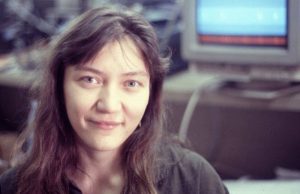Misha Mahowald

Michelle “Misha” Mahowald (1963-1996) was a United States computational neuroscientist and a pioneer in the emerging field of neuromorphic engineering, also known as neuromorphic computing. It involves the use of very-large-scale integration (VLSI) systems containing electronic analog circuits to mimic neuro-biological architectures present in the nervous system.
Mahowald is chiefly known for inventing a silicon retina – the so called “Silicon Eye” – with an AER interface. Her invention was highly original and was widely hailed as one of the most eclectic feats of electrical and biological engineering at the time. It was the first ever integrated silicon retina, and it used analog electrical circuits to mimic the biological functions of rod cells, cone cells and other non-photoreceptive cells in the eye´s retina.
Mahowald´s invention of the silicon retina and the silicon neuron earned her four patents and the prestigious Clauser Prize. Her PhD work appeared on the covers of both Nature and Scientific American, and a revised version of her 1992 doctoral dissertation was eventually published in book form.
For her development of the Silicon Eye and other computational systems, Mahowald was inducted into the Women in Technology International Hall of Fame in 1996.
Today, in the 21st century, Mahowald´s novel designs of brain-inspired CMOS VLSI circuits for vision and computation continue to serve as an inspiration for reseachers in the field of neuromorphic computing.
Background and personal life
Michelle Anne Mahowald was born on January 12, 1963, in Minneapolis, Minnesota, USA. She was the daughter of Alfred and Joan Fischer Mahowald, and she had a younger sister named Sheila.
At the age of 33, Mahowald committed suicide in Switzerland suffering from a psychosis and she died in Zürich on December 26, 1996.
Education
After graduating high school, Mahowald enrolled at Caltech where and graduated with a degree in biology in 1985. She stayed at Caltech to pursue her PhD in Computation and Neural System, an for her doctoral thesis she combined the fields of biology, computer science, and electrical engineering to produce a silicon retina. Her doctoral advisor was Professor Carver Mead, a specialist in VLSI.
Thesis: VLSI analogs of neuronal visual processing: a synthesis of form and function (1992)
https://thesis.library.caltech.edu/6663/
Post-doc work
After the success of her silicon retina, Mahowald moved to England to do a one-year-long post-doctoral fellowship at the University of Oxford, working with the renowned neuroscientists Kevan Martin and Rodney Douglas.
After her stint in England, it was time to move to Zürich to help establish the Institut für Neuroinformatik (Institute of Neuroinformatics) at the University of Zürich and ETH Zurich. Institut für Neuroinformatik is a research institution focused on discovering key principles for how the brain works and use this knowledge to create artificial systems that interact intelligently with the world.
The Misha Mahowald Prize for Neuromorphic Engineering
- The Misha Mahowald Prize for Neuromorphic Engineering has been established to recognize outstanding research achievements in the field of neuromorphic engineering.
- The Mahowald Early Career Award has been established for individual Master’s, PhD, and early postdoctoral students.
The Misha Mahowald Prize for Neuromorphic Engineering was first awarded in 2016. For the time period 2016-2020, the recipients have been:
2020: Prof. Shih-Chii Liu and team for “Hearing with Silicon Cochleas”
2019: Greg Cohen and team, Western Sydney University
2018: No award
2017: Davide Scaramuzza and team, University of Zurich
2016: Dharmendra Modha and team, IBM Research – Almaden





